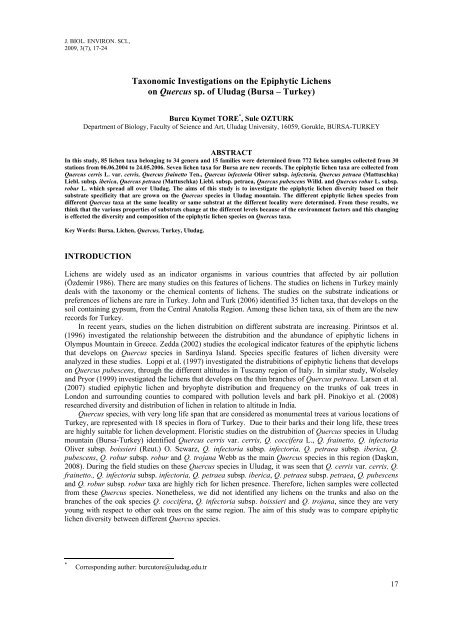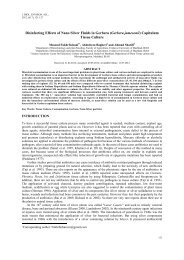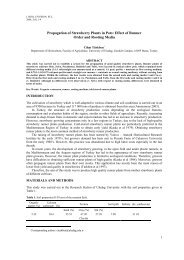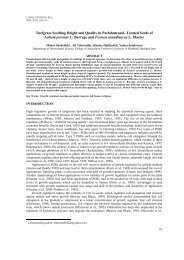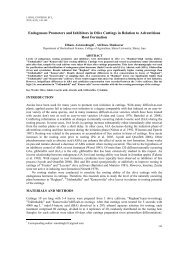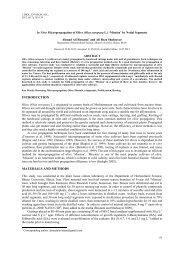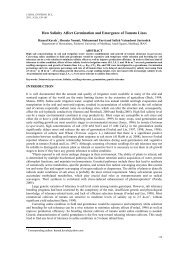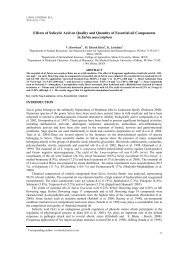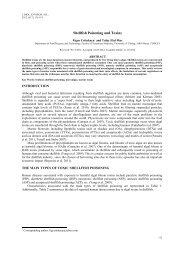Taxonomic Investigations on the Epiphytic Lichens on Quercus sp ...
Taxonomic Investigations on the Epiphytic Lichens on Quercus sp ...
Taxonomic Investigations on the Epiphytic Lichens on Quercus sp ...
You also want an ePaper? Increase the reach of your titles
YUMPU automatically turns print PDFs into web optimized ePapers that Google loves.
J. BIOL. ENVIRON. SCI.,<br />
2009, 3(7), 17-24<br />
<str<strong>on</strong>g>Tax<strong>on</strong>omic</str<strong>on</strong>g> <str<strong>on</strong>g>Investigati<strong>on</strong>s</str<strong>on</strong>g> <strong>on</strong> <strong>the</strong> <strong>Epiphytic</strong> <strong>Lichens</strong><br />
<strong>on</strong> <strong>Quercus</strong> <strong>sp</strong>. of Uludag (Bursa – Turkey)<br />
Burcu Kıymet TORE * , Sule OZTURK<br />
Department of Biology, Faculty of Science and Art, Uludag University, 16059, Gorukle, BURSA-TURKEY<br />
ABSTRACT<br />
In this study, 85 lichen taxa bel<strong>on</strong>ging to 34 genera and 15 families were determined from 772 lichen samples collected from 30<br />
stati<strong>on</strong>s from 06.06.2004 to 24.05.2006. Seven lichen taxa for Bursa are new records. The epiphytic lichen taxa are collected from<br />
<strong>Quercus</strong> cerris L. var. cerris, <strong>Quercus</strong> frainetto Ten., <strong>Quercus</strong> infectoria Oliver sub<strong>sp</strong>. infectoria, <strong>Quercus</strong> petraea (Mattuschka)<br />
Liebl. sub<strong>sp</strong>. iberica, <strong>Quercus</strong> petraea (Mattuschka) Liebl. sub<strong>sp</strong>. petraea, <strong>Quercus</strong> pubescens Willd. and <strong>Quercus</strong> robur L. sub<strong>sp</strong>.<br />
robur L. which <strong>sp</strong>read all over Uludag. The aims of this study is to investigate <strong>the</strong> epiphytic lichen diversity based <strong>on</strong> <strong>the</strong>ir<br />
substrate <strong>sp</strong>ecificity that are grown <strong>on</strong> <strong>the</strong> <strong>Quercus</strong> <strong>sp</strong>ecies in Uludag mountain. The different epiphytic lichen <strong>sp</strong>ecies from<br />
different <strong>Quercus</strong> taxa at <strong>the</strong> same locality or same substrat at <strong>the</strong> different locality were determined. From <strong>the</strong>se results, we<br />
think that <strong>the</strong> various properties of substrats change at <strong>the</strong> different levels because of <strong>the</strong> envir<strong>on</strong>ment factors and this changing<br />
is effected <strong>the</strong> diversity and compositi<strong>on</strong> of <strong>the</strong> epiphytic lichen <strong>sp</strong>ecies <strong>on</strong> <strong>Quercus</strong> taxa.<br />
Key Words: Bursa, Lichen, <strong>Quercus</strong>, Turkey, Uludag.<br />
INTRODUCTION<br />
<strong>Lichens</strong> are widely used as an indicator organisms in various countries that affected by air polluti<strong>on</strong><br />
(Özdemir 1986). There are many studies <strong>on</strong> this features of lichens. The studies <strong>on</strong> lichens in Turkey mainly<br />
deals with <strong>the</strong> tax<strong>on</strong>omy or <strong>the</strong> chemical c<strong>on</strong>tents of lichens. The studies <strong>on</strong> <strong>the</strong> substrate indicati<strong>on</strong>s or<br />
preferences of lichens are rare in Turkey. John and Turk (2006) identified 35 lichen taxa, that develops <strong>on</strong> <strong>the</strong><br />
soil c<strong>on</strong>taining gypsum, from <strong>the</strong> Central Anatolia Regi<strong>on</strong>. Am<strong>on</strong>g <strong>the</strong>se lichen taxa, six of <strong>the</strong>m are <strong>the</strong> new<br />
records for Turkey.<br />
In recent years, studies <strong>on</strong> <strong>the</strong> lichen distrubiti<strong>on</strong> <strong>on</strong> different substrata are increasing. Pirintsos et al.<br />
(1996) investigated <strong>the</strong> relati<strong>on</strong>ship betweeen <strong>the</strong> distrubiti<strong>on</strong> and <strong>the</strong> abundance of epiphytic lichens in<br />
Olympus Mountain in Greece. Zedda (2002) studies <strong>the</strong> ecological indicator features of <strong>the</strong> epiphytic lichens<br />
that develops <strong>on</strong> <strong>Quercus</strong> <strong>sp</strong>ecies in Sardinya Island. Species <strong>sp</strong>ecific features of lichen diversity were<br />
analyzed in <strong>the</strong>se studies. Loppi et al. (1997) investigated <strong>the</strong> distrubiti<strong>on</strong>s of epiphytic lichens that develops<br />
<strong>on</strong> <strong>Quercus</strong> pubescens, through <strong>the</strong> different altitudes in Tuscany regi<strong>on</strong> of Italy. In similar study, Wolseley<br />
and Pryor (1999) investigated <strong>the</strong> lichens that develops <strong>on</strong> <strong>the</strong> thin branches of <strong>Quercus</strong> petraea. Larsen et al.<br />
(2007) studied epiphytic lichen and bryophyte distributi<strong>on</strong> and frequency <strong>on</strong> <strong>the</strong> trunks of oak trees in<br />
L<strong>on</strong>d<strong>on</strong> and surrounding counties to compared with polluti<strong>on</strong> levels and bark pH. Pinokiyo et al. (2008)<br />
researched diversity and distributi<strong>on</strong> of lichen in relati<strong>on</strong> to altitude in India.<br />
<strong>Quercus</strong> <strong>sp</strong>ecies, with very l<strong>on</strong>g life <strong>sp</strong>an that are c<strong>on</strong>sidered as m<strong>on</strong>umental trees at various locati<strong>on</strong>s of<br />
Turkey, are represented with 18 <strong>sp</strong>ecies in flora of Turkey. Due to <strong>the</strong>ir barks and <strong>the</strong>ir l<strong>on</strong>g life, <strong>the</strong>se trees<br />
are highly suitable for lichen development. Floristic studies <strong>on</strong> <strong>the</strong> distrubiti<strong>on</strong> of <strong>Quercus</strong> <strong>sp</strong>ecies in Uludag<br />
mountain (Bursa-Turkey) identified <strong>Quercus</strong> cerris var. cerris, Q. coccifera L., Q. frainetto, Q. infectoria<br />
Oliver sub<strong>sp</strong>. boissieri (Reut.) O. Scwarz, Q. infectoria sub<strong>sp</strong>. infectoria, Q. petraea sub<strong>sp</strong>. iberica, Q.<br />
pubescens, Q. robur sub<strong>sp</strong>. robur and Q. trojana Webb as <strong>the</strong> main <strong>Quercus</strong> <strong>sp</strong>ecies in this regi<strong>on</strong> (Daşkın,<br />
2008). During <strong>the</strong> field studies <strong>on</strong> <strong>the</strong>se <strong>Quercus</strong> <strong>sp</strong>ecies in Uludag, it was seen that Q. cerris var. cerris, Q.<br />
frainetto., Q. infectoria sub<strong>sp</strong>. infectoria, Q. petraea sub<strong>sp</strong>. iberica, Q. petraea sub<strong>sp</strong>. petraea, Q. pubescens<br />
and Q. robur sub<strong>sp</strong>. robur taxa are highly rich for lichen presence. Therefore, lichen samples were collected<br />
from <strong>the</strong>se <strong>Quercus</strong> <strong>sp</strong>ecies. N<strong>on</strong>e<strong>the</strong>less, we did not identified any lichens <strong>on</strong> <strong>the</strong> trunks and also <strong>on</strong> <strong>the</strong><br />
branches of <strong>the</strong> oak <strong>sp</strong>ecies Q. coccifera, Q. infectoria sub<strong>sp</strong>. boissieri and Q. trojana, since <strong>the</strong>y are very<br />
young with re<strong>sp</strong>ect to o<strong>the</strong>r oak trees <strong>on</strong> <strong>the</strong> same regi<strong>on</strong>. The aim of this study was to compare epiphytic<br />
lichen diversity between different <strong>Quercus</strong> <strong>sp</strong>ecies.<br />
*<br />
Corre<strong>sp</strong><strong>on</strong>ding au<strong>the</strong>r: burcutore@uludag.edu.tr<br />
17
J. BIOL. ENVIRON. SCI.,<br />
2009, 3(7), 17-24<br />
MATERIALS AND METHODS<br />
Study area<br />
Bursa is located at latitude 39–40° N, l<strong>on</strong>gitude 28–29° E in <strong>the</strong> north-west of Turkey, south-west of <strong>the</strong><br />
Marmara Regi<strong>on</strong>. Bursa is affected by a A Mediterranean climate (Akman 1999). The mean annual rainfall is<br />
731,1 mm, and <strong>the</strong> mean maximum temperature is 30,9 °C in August, while <strong>the</strong> mean minimum temperature<br />
is 1,7 °C in January (DGIGM 1974). Uludag mountain, which is <strong>the</strong> study area, is located at latitude 40° N<br />
and l<strong>on</strong>gitude 29° E in <strong>the</strong> south of Bursa. It is <strong>the</strong> highest mountain in Western Anatolia, with its peak at<br />
Uludag Tepe (2543m). Sarıalan Yaylası, Kirazlıyayla, Kadıyayla, Sobra Yaylası which high plateaus are <strong>on</strong><br />
<strong>the</strong> nor<strong>the</strong>rn side of <strong>the</strong> Uludag. There are some glacial lakes <strong>on</strong> <strong>the</strong> high summits of <strong>the</strong> mountain such as<br />
Aynalıgöl, Buzlugöl, Karagöl, Kilimligöl (Kaynak et al. 2005).Uludag is affected by a Mediterranean climate<br />
type and frozen in winter. Uludag’s climate changes from lower to higher altitudes (Akman 1999).<br />
Uludag have 5 vegetati<strong>on</strong> z<strong>on</strong>es; Lauretum (up to 350 m), Castanetum (up to 350–700 m), Fagetum<br />
(750–1500 m), Abietum (1500–2100 m), Alpinetum (up to 2100 m) (Özhatay and Çırpıcı 1987).<br />
Mediterranean vegetati<strong>on</strong> such as maquis and frigana is present up to 350 m <strong>on</strong> Uludag (Çetin 1999).<br />
Collecting samples and identificati<strong>on</strong><br />
85 lichen taxa bel<strong>on</strong>ging to 34 genera and 15 families were determined from 772 lichen samples collected<br />
from 30 stati<strong>on</strong>s between 06.06.2004 and 24.05.2006(Table 1).<br />
The lichen samples were examined with a stereomicroscope (Olympus SZ 40) and a high power<br />
microscope (Olympus CH–2) for external morphology and anatomical observati<strong>on</strong>s. The lichen samples were<br />
identified with <strong>the</strong> and of several flora books and identificati<strong>on</strong> keys (Clauzade and Roux 1985, Jahns 1987,<br />
Purvis et al. 1994, Wirth 1995, Brodo et al. 2001, Giralt 2001, Blanco et al. 2004, Nash III et al. I-II, 2004).<br />
Specimens are deposited in <strong>the</strong> Herbarium of <strong>the</strong> Biology Department (BULU) of <strong>the</strong> Faculty of Art and<br />
Sciences Uludag University in Bursa. Authors names are abbreviated according to Brummitt and Powell<br />
(1992).<br />
The <strong>Quercus</strong> <strong>sp</strong>p. were identified with several flora books and identificati<strong>on</strong> keys (Davis et al. 1982,<br />
Yaltırık 1984, Mataracı 2004).<br />
RESULTS<br />
In this study, 772 lichen samples were determined <strong>on</strong> <strong>Quercus</strong> <strong>sp</strong>p. (Table 2). 85 lichen taxa bel<strong>on</strong>g to 34<br />
genera are reported <strong>on</strong> <strong>Quercus</strong> <strong>sp</strong>p. of <strong>the</strong>se <strong>sp</strong>ecimens, 61 taxa were found <strong>on</strong> Q. cerris var. cerris, 59 <strong>on</strong> Q.<br />
petraea s<strong>sp</strong>. iberica, 56 <strong>on</strong> Q. petraea s<strong>sp</strong>. petraea, 32 <strong>on</strong> Q. pubescens, 21 <strong>on</strong> Q. frainetto, 21 <strong>on</strong> Q.<br />
infectoria s<strong>sp</strong>. infectoria and 19 <strong>on</strong> Q. robur s<strong>sp</strong>. robur (Table 3). According to <strong>the</strong> literatures, 7 taxa are<br />
recorded first time from Bursa. These <strong>sp</strong>ecies are Candelariella reflexa (Nyl.) Lettau, Lecanora allophana<br />
(Ach.) Rühl., L. expallens Ach., L. glabrata (Ach.) Malme, Clad<strong>on</strong>ia digitata (L.) Hoffm., Lecanora<br />
intumescens (Rebent.) Rabenh. and Usnea chaetophora Stirt.<br />
It was observed that seven lichen <strong>sp</strong>ecies grow <strong>on</strong> all examined <strong>Quercus</strong> <strong>sp</strong>p. (Table 2). According to<br />
<strong>the</strong> literature, <strong>the</strong>se <strong>sp</strong>ecies are cosmopolite. In our study, ıt was identified that <strong>the</strong>se <strong>sp</strong>ecies have no<br />
selectivity for substrate and have high tolerance for Evernia prunastri (L.) Ach., Lecanora carpinea (L.)<br />
Vain., L. subcarpinea Szatala, Lecidella elaeochroma (Ach.) M. Choisy, Melanelixia fuliginosa s<strong>sp</strong>.<br />
glabratula (Lamy) Coppins, Pleurosticta acetabulum (Neck.) Elix & Lumbsch and Pseudevernia furfuracea<br />
var. furfuracea (L.) Zopf.<br />
18
J. BIOL. ENVIRON. SCI.,<br />
2009, 3(7), 17-24<br />
Table 1. List of <strong>the</strong> localities.<br />
Altitude Coordinate<br />
Localities and subtrates<br />
Date<br />
(m) (N-E)<br />
1 İnegöl Soğukdere-Hamidiye, 1 km from Kestanealanı, Q. p. s<strong>sp</strong>. iberica, Q. p. s<strong>sp</strong>. petraea. 475–666 40º02'- 29º28' 06.06.2004<br />
2 İnegöl in <strong>the</strong> vicinity of Gülbahçe, Q. p. s<strong>sp</strong>. petraea. 696–740 40º01' - 29º26' 06.06.2004<br />
3 İnegöl Çayyaka-Lütfiye, after 1. km from Çayyaka, Q. r.s<strong>sp</strong>. robur. 489–565 39º59' - 29º28' 06.06.2004<br />
4 İnegöl Çayyaka-Lütfiye, 1 km to Lütfiye, <strong>Quercus</strong> <strong>sp</strong>. forest, Q. p. s<strong>sp</strong>. iberica. 743 39º59' - 29º27' 06.06.2004<br />
5 İnegöl İnegöl-Keles, 3. km from Çayyaka, Q. r. s<strong>sp</strong>. robur. 693 39º59' - 29º27' 06.06.2004<br />
6 İnegöl İsaören -Karakadı, 1. km from İsaören, <strong>on</strong> Q. c. s<strong>sp</strong>. cerris. 453–532 40º01' - 29º30' 13.06.2004<br />
7 İnegöl İsaören-Kestanealanı, 1. km from Karakadı, <strong>on</strong> Q. .r s<strong>sp</strong>. robur. 611 40º00' - 29º29' 13.06.2004<br />
8 İnegöl Kestanealanı-İclaliye, 1. km from Kestanealanı, Q. p. s<strong>sp</strong>. iberica, Q. p. s<strong>sp</strong>. petraea. 704–715 39º59' - 29º29' 13.06.2004<br />
9 İnegöl Soğukdere-Hamidiye, 1 km from Kestanealanı, Q. p. s<strong>sp</strong>. iberica, Q. p. s<strong>sp</strong>. petraea. 475–666 39º58’- 29º31' 13.06.2004<br />
10 İnegöl in <strong>the</strong> vicinity of Hayriye, forest and rocky area, Q. c. s<strong>sp</strong>. cerris. 739–773 39º57' - 29º33' 20.06.2004<br />
11 İnegöl in <strong>the</strong> vicinity of Bahariye, <strong>Quercus</strong> <strong>sp</strong>. forest, Q. c. s<strong>sp</strong>. cerris. 629–646 39º57'- 29º35' 20.06.2004<br />
12 İnegöl in <strong>the</strong> vicinity of Mezit, Fagus <strong>sp</strong>. and <strong>Quercus</strong> <strong>sp</strong>. forest, Q. c. s<strong>sp</strong>. cerris. 648–779 39º56' - 29º44' 11.07.2004<br />
13 İnegöl Sulhiye-Osmaniye road, 1 km from Sulhiye, Q. frainetto. 671 39º56' - 29º42' 11.07.2004<br />
14 İnegöl in <strong>the</strong> vicinity of Akıncılar, <strong>Quercus</strong> <strong>sp</strong>. forest, Q. p. s<strong>sp</strong>. iberica. 426 40º06' - 29º23' 11.07.2004<br />
15 İnegöl in <strong>the</strong> vicinity of Çürüksu, Q. c. s<strong>sp</strong>. cerris. 789 39º55' - 29º37' 19.09.2004<br />
16 İnegöl in <strong>the</strong> vicinity of Elmaçayır, <strong>Quercus</strong> <strong>sp</strong>. forest, Q. c. s<strong>sp</strong>. cerris. 850–885 40º01' - 29º23' 19.10.2003<br />
17 Uludag 1 km to Hüseyinalan, Q. p. s<strong>sp</strong>. petraea. 960 40º08' - 29º01' 09.06.2005<br />
18 Uludag 1 km to Kirazlı, Q. p. s<strong>sp</strong>. petraea. 1000 40º07' - 29º02' 16.06.2005<br />
19 Uludag 1 km from Hüseyinalan, Q. p. s<strong>sp</strong>. petraea. 900 40º07' - 29º01' 16.06.2005<br />
20 Uludag 5m to Hüseyinalan, Q. p. s<strong>sp</strong>. petraea. 900 40º08'- 29º01' 16.06.2005<br />
21 Uludag in <strong>the</strong> vicinity of Highway fountain,Q. p.s<strong>sp</strong>. petraea. 1008 40º07' - 29º02' 28.08.2005<br />
22 Uludag Uludag road, <strong>Quercus</strong> <strong>sp</strong>. forest, Q. p. s<strong>sp</strong>. petraea. 852 40º08' - 29º01' 14.09.2005<br />
23 Uludag Hüseyinalan village road, <strong>Quercus</strong> <strong>sp</strong>. forest, Q. p. s<strong>sp</strong>. petraea. 897 40º07' - 29º02' 14.09.2005<br />
24 Uludag Exit of Hüseyinalan village, Q. c. s<strong>sp</strong>. cerris, Q. p. s<strong>sp</strong>. iberica, Q. p. s<strong>sp</strong>. petraea. 969 40º06'- 29º01' 14.09.2005<br />
25 Uludag Bağlı picnic area, Q. c.s<strong>sp</strong>. cerris, Q. pubescens. 1177 40º04'- 29º05' 24.05.2006<br />
26 Uludag 5 km from Bağlı picnic area, Q. c. s<strong>sp</strong>. cerris, Q. pubescens. 1102 40º04'- 29º06' 24.05.2006<br />
27 Uludag 2 km to Soğukpınar, Q. frainetto, Q. pubescens. 1063 40º03'- 29º06' 24.05.2006<br />
28 Uludag Soğukpınar-Keles, exit of Soğukpınar, 2 km, Q. i. s<strong>sp</strong>. infectoria. 841 40º01'- 29º07' 24.05.2006<br />
29 Uludag Bursa-Keles, 2 km from Çaybaşı, near <strong>the</strong> roadside, Q. i. s<strong>sp</strong>. infectoria. 549 40º03'- 29º03' 24.05.2006<br />
30 Uludag Keles-Bursa, Q. c. s<strong>sp</strong>. cerris, Q. pubescens. 418 40º04'- 29º00' 24.05.206<br />
In this study, Q. cerris var. cerris, which found in 10 different localities is <strong>the</strong> richest lichen flora (Table<br />
3). It is known that <strong>the</strong> age of tree is importance factor <strong>on</strong> <strong>the</strong> lichen diversity (Brodo et al. 2001). Ag<strong>on</strong>imia<br />
allobata, Caloplaca cerina var. cerina, Ochrolechia arborea, O. turneri, Parmelina pastillifera, Pertusaria<br />
pertusa, Usnea chaetophora, U. florida and U. fulvoreagens were found <strong>on</strong>ly <strong>on</strong> Q. cerris var. cerris (Table<br />
2). Usnea chaetophora which growing <strong>on</strong> <strong>the</strong> trunk of Q. cerris var. cerris and is found at 850 – 885 m, is <strong>the</strong><br />
new record for Uludag.<br />
Q. petraea s<strong>sp</strong>. iberica has a lichen flora of 59 taxa which found in 6 localities in Uludag (Table 3). Six<br />
lichen <strong>sp</strong>ecies were found <strong>on</strong>ly Q. petraea s<strong>sp</strong>. iberica. These are Caloplaca cerinelloides, Lobaria<br />
pulm<strong>on</strong>aria, Ochrolechia tartarea, Peltigera canina, Pertusaria cor<strong>on</strong>ata and Phaeophyscia ciliata.<br />
56 lichen <strong>sp</strong>ecies were determinated <strong>on</strong> Q. petraea s<strong>sp</strong>. petraea. Six lichen <strong>sp</strong>ecies were found <strong>on</strong>ly Q.<br />
petraea s<strong>sp</strong>. petraea. These are Clad<strong>on</strong>ia digitata, Lecanora allophana, L. expallens, L. glabrata, Peltigera<br />
horiz<strong>on</strong>talis (Huds.) Baumg and Tephromela atra (Huds.) Hafellner. Clad<strong>on</strong>ia digitata, Lecanora allophana,<br />
L. expallens and L. glabrata are <strong>the</strong> first record from Uludag where <strong>the</strong> <strong>sp</strong>ecies are found at 850–900 m, 900–<br />
1010 m, 900–960 m and 897 m at re<strong>sp</strong>ectively, <strong>on</strong> <strong>the</strong> trunk of Q. petraea s<strong>sp</strong>. petraea. Q. pubescens has 32<br />
taxa. Caloplaca cerinella and Collema subflaccidum were found <strong>on</strong>ly <strong>on</strong> Q. pubescens. Q. infectoria s<strong>sp</strong>.<br />
infectoria and Q. frainetto has 21 taxa and <strong>the</strong>refore lichen diversity of <strong>the</strong>se is poorer than <strong>the</strong> o<strong>the</strong>r <strong>sp</strong>ecies.<br />
Physc<strong>on</strong>ia detersa were found <strong>on</strong>ly <strong>on</strong> Q. frainetto. Q. robur s<strong>sp</strong>. robur has <strong>the</strong> poorest lichen flora with 19<br />
taxa.<br />
Lecanora intumescens is <strong>the</strong> first record from Uludag. It was found <strong>on</strong> <strong>the</strong> trunk of Q. petraea s<strong>sp</strong>.<br />
petraea and Q. cerris var. cerris. Caloplaca holocarpa, Candelariella vitellina, Physcia adscendens and<br />
Xanthoria parietina were found <strong>on</strong> all <strong>Quercus</strong> <strong>sp</strong>p substrates except for Q. robur s<strong>sp</strong>. robur (Table 2).<br />
19
J. BIOL. ENVIRON. SCI.,<br />
2009, 3(7), 17-24<br />
Table 2. The number of identified lichen taxa <strong>on</strong> <strong>Quercus</strong> <strong>sp</strong>p.<br />
A: Q. cerris L. var. Cerris, B: Q. frainetto Ten., C. Q.infectoria Oliver sub<strong>sp</strong>. infectoria, D: Q. petraea (Mattuschka) Liebl. sub<strong>sp</strong>.<br />
iberica, E: Q.petraea (Mattuschka) Liebl. sub<strong>sp</strong>. petraea, F: Q. pubescens Willd., G: <strong>Quercus</strong> robur L. sub<strong>sp</strong>. robur L.<br />
Taxa A B C D E F G Total lichen samples<br />
Ag<strong>on</strong>imia allobata (Stizenb.) P. James 1 1<br />
Anaptychia ciliaris (L.) Körb. ex A. Massal. 3 3 5 1 12<br />
Bryoria fuscescens (Gyeln.) Brodo & D. Hawksw. 1 1 4 6<br />
Buellia disciformis (Fr.) Mudd 2 3 5<br />
Caloplaca cerina (Ehrh. ex Hedw.) Th. Fr. var. cerina 2 2<br />
Caloplaca cerinella (Nyl.) Flagey 1 1<br />
Caloplaca cerinelloides (Erichsen) Poelt 1 1<br />
Caloplaca flavorubescens (Huds.) J.R. Laund<strong>on</strong> 1 1<br />
Caloplaca holocarpa (Hoffm.) A. E. Wade 4 2 1 2 4 6 19<br />
Candelariella reflexa (Nyl.) Lettau 1 1 2<br />
Candelariella vitellina (Hoffm.) Müll. Arg. 3 1 3 2 4 3 16<br />
Clad<strong>on</strong>ia c<strong>on</strong>iocraea (Flörke) Spreng. 1 1 2<br />
Clad<strong>on</strong>ia digitata (L.) Hoffm. 3 3<br />
Clad<strong>on</strong>ia fimbriata (L.) Fr. 2 2 7 11<br />
Collema subflaccidum Degel. 1 1<br />
Evernia prunastri (L.) Ach. 4 3 2 7 9 4 3 32<br />
Hypogymnia farinacea Zopf 1 1 2<br />
Hypogymnia physodes (L.) Nyl. 1 3 8 2 14<br />
Hypogymnia tubulosa (Schaer.) Hav. 7 2 3 6 1 19<br />
Lecanora allophana (Ach.) Rühl. 3 3<br />
Lecanora carpinea (L.) Vain. 8 2 1 3 8 3 2 27<br />
Lecanora chlarotera Nyl. 7 1 5 8 4 1 26<br />
Lecanora expallens Ach. 2 2<br />
Lecanora glabrata (Ach.) Malme 1 1<br />
Lecanora hagenii (Ach.) Ach. 1 1 2<br />
Lecanora intumescens (Rebent.) Rabenh. 1 1 2<br />
Lecanora subcarpinea Szatala 4 2 1 1 5 4 2 19<br />
Lecidella elaeochroma (Ach.) M. Choisy 10 2 1 13 20 5 1 52<br />
Lepraria incana (L.) Ach. 2 1 3 1 7<br />
Lepraria lobificans Nyl. 2 1 1 3 7<br />
Lobaria pulm<strong>on</strong>aria (L.) Hoffm. 1 1<br />
Melanelixia fuliginosa sub<strong>sp</strong>. glabratula (Lamy) J.R.<br />
Laund<strong>on</strong><br />
1 1 1 2 7 1 2 15<br />
Melanelixia glabra (Schaer.) O. Blanco et al. 7 6 7 20<br />
Melanelixia subaurifera (Nyl.) O. Blanco et al. 2 2 4 2 10<br />
Melanohalea exa<strong>sp</strong>erata (De Not.) O. Blanco et al. 6 2 3 1 12<br />
Melanohalea exa<strong>sp</strong>eratula (Nyl.) O. Blanco et al. 1 2 1 1 3 8<br />
Ochrolechia arborea (Kreyer) Almb. 1 1<br />
Ochrolechia pallescens (L.) A. Massal. 1 1 2 4<br />
Ochrolechia szatalaensis Verseghy 1 3 4<br />
Ochrolechia tartarea (L.) A. Massal. 1 1<br />
Ochrolechia turneri (Sm.) Hasselrot 1 1<br />
Parmelia sulcata Taylor 10 1 6 13 3 33<br />
Parmelina pastillifera (Harm.) Hale 3 1 4<br />
Parmelina quercina var. carporrhizans (Taylor) V. Wirth 3 1 6 10<br />
Parmelina quercina var. quercina (Willd.) Hale 7 2 4 3 1 1 18<br />
Parmelina tiliacea (Hoffm.) Hale 5 4 7 16<br />
Peltigera canina (L.) Willd. 1 1<br />
20
J. BIOL. ENVIRON. SCI.,<br />
2009, 3(7), 17-24<br />
Table 2. C<strong>on</strong>tinued.<br />
Taxa A B C D E F G Total lichen samples<br />
Peltigera horiz<strong>on</strong>talis (Huds.) Baumg 2 2<br />
Peltigera polydactyl<strong>on</strong> (Neck.) Hoffm. 1 1 2 4<br />
Peltigera praetextata (Flörke ex Sommerf.) Vain. 1 3 4 2 10<br />
Peltigera rufescens (Weiss) Humb. 2 4 6<br />
Pertusaria albescens (Huds.) M. Choisy & Werner 4 1 2 5 12<br />
Pertusaria cor<strong>on</strong>ata (Ach.) Th. Fr. 2 2<br />
Pertusaria flavida (DC.) J.R. Laund<strong>on</strong> 3 1 4<br />
Pertusaria pertusa (Weigel) Tuck. 1 1<br />
Phaeophyscia ciliata (Hoffm.) Moberg 1 1<br />
Phaeophyscia orbicularis (Neck.) Moberg 1 2 3<br />
Phlyctis argena (Spreng.) Flot. 3 2 9 3 17<br />
Physcia adscendens (Th. Fr.) H. Olivier 2 1 3 5 2 1 14<br />
Physcia aipolia (Ehrh. ex Humb.) Fürnr. 2 1 5 9 1 18<br />
Physcia leptalea (Ach.) DC. 1 2 1 3 2 9<br />
Physcia stellaris (L.) Nyl. 4 2 1 2 5 1 15<br />
Physcia tenella (Scop.) DC. 2 1 3 6<br />
Physc<strong>on</strong>ia detersa (Nyl.) Poelt 1 1<br />
Physc<strong>on</strong>ia distorta (With.) J.R. Laund<strong>on</strong> 5 5 10 1 21<br />
Physc<strong>on</strong>ia enteroxantha (Nyl.) Poelt 2 1 4 8 1 16<br />
Physc<strong>on</strong>ia perisidiosa (Erichsen) Moberg 1 3 1 5<br />
Platismatia glauca (L.) W.L. Culb. & C.F. Culb. 2 1 4<br />
Pleurosticta acetabulum (Neck.) Elix & Lumbsch 5 1 1 6 10 2 1<br />
Pseudevernia furfuracea var. ceratea (Ach.) D. Hawksw. 1 3 4<br />
Pseudevernia furfuracea var. furfuracea (L.) Zopf 8 1 1 4 5 2 1 22<br />
Ramalina farinacea (L.) Ach. 2 3 3 5 1 14<br />
Ramalina fastigiata (Pers.) Ach. 2 1 1 4<br />
Ramalina fraxinea (L.) Ach. 3 2 1 1 7<br />
Rinodina exigua Gray 2 1 2 4 9<br />
Rinodina sophodes (Ach.) A. Massal. 8 1 1 10<br />
Tephromela atra (Huds.) Hafellner 2 2<br />
Usnea chaetophora Stirt. 1 1<br />
Usnea filipendula Stirt. 2 2 4 8<br />
Usnea florida (L.) Weber ex F.H. Wigg. 1 1<br />
Usnea fulvoreagens (Räsänen) Räsänen 1 1<br />
Usnea glabrescens (Nyl. ex Vain.) Vain. 2 1 2 5<br />
Usnea hirta (L.) F. H. Wigg. 1 2 1 4<br />
Xanthoria fulva (Hoffm.) Poelt & Petut. 1 1 2<br />
Xanthoria parietina (L.) Th. Fr. 5 1 4 4 2 5 21<br />
Total lichen taxa 61 21 21 59 56 32 19<br />
Total lichen samples 772<br />
Our study indicated that am<strong>on</strong>g <strong>the</strong> lichen growth forms of 85 lichen taxa, foliose lichens (40,00 % of all<br />
lichen <strong>sp</strong>ecies) were predominatly followed by crustose (36,47 %), fruticose (17,64 %), dimorphic lichens<br />
(3,52 %) and leprose (2,35 %).<br />
35 taxa of foliose lichens and 15 taxa of crustose lichens were determined <strong>on</strong> Q. petraea s<strong>sp</strong>. iberica. 33<br />
taxa of foliose lichens and 16 taxa of crustose lichens were determined <strong>on</strong> Q. petraea s<strong>sp</strong>. petraea. While <strong>the</strong><br />
crustose lichens and fruticose lichens are dominant <strong>on</strong> Q. cerris var. cerris, <strong>the</strong>se are less <strong>on</strong> Q. robur s<strong>sp</strong>.<br />
robur. Foliose lichens are dominant <strong>on</strong> Q. petraea s<strong>sp</strong>. iberica (Table 4).<br />
21
J. BIOL. ENVIRON. SCI.,<br />
2009, 3(7), 17-24<br />
Table 3. The Percent and The Number of Total <strong>Epiphytic</strong> <strong>Lichens</strong> <strong>on</strong> <strong>Quercus</strong> Taxa.<br />
The number of total epiphytic lichens <strong>on</strong> <strong>Quercus</strong> taxa<br />
% Lichen taxa<br />
<strong>Quercus</strong> cerris L. var. cerris 61 22,76<br />
<strong>Quercus</strong> frainetto Ten. 21 7,83<br />
<strong>Quercus</strong> infectoria Olivier sub<strong>sp</strong>. infectoria 21 7,83<br />
<strong>Quercus</strong> (Mattuschka) Liebl. sub<strong>sp</strong>. iberica 59 22,01<br />
<strong>Quercus</strong> (Mattuschka) Liebl. sub<strong>sp</strong>. petraea 56 20,89<br />
<strong>Quercus</strong> pubescens Willd. 32 11,94<br />
<strong>Quercus</strong> robur L. sub<strong>sp</strong>. robur L. 19 7,08<br />
Total number 268 100<br />
Table 4. The distributi<strong>on</strong> of <strong>the</strong> lichen growth forms <strong>on</strong> <strong>Quercus</strong> Taxa.<br />
22<br />
The lichen<br />
growth<br />
forms<br />
<strong>Quercus</strong><br />
cerris L. var.<br />
cerris<br />
<strong>Quercus</strong><br />
frainetto<br />
Ten.<br />
<strong>Quercus</strong><br />
infectoria<br />
Oliver<br />
sub<strong>sp</strong>.<br />
infectoria<br />
<strong>Quercus</strong> <strong>Quercus</strong><br />
petraea petraea<br />
(Mattuschka) (Mattuschka)<br />
Liebl. sub<strong>sp</strong>. Liebl. sub<strong>sp</strong>.<br />
iberica petraea<br />
<strong>Quercus</strong><br />
pubescens<br />
Willd.<br />
<strong>Quercus</strong><br />
robur L.<br />
sub<strong>sp</strong>. robur<br />
L.<br />
Fruticose 10 - 1 7 5 2 1<br />
Foliose 29 13 11 35 33 19 11<br />
Crustose 20 8 8 15 16 9 5<br />
Dimorphic 1 - 1 - - - -<br />
Leprose 1 - - 2 2 1 2<br />
Total 61 21 21 59 56 31 19<br />
DISCUSSION<br />
When <strong>the</strong> results of this study were compared to <strong>the</strong> studies <strong>on</strong> similar substrates in Mediterranean regi<strong>on</strong>,<br />
<strong>the</strong>re are several similarities to <strong>the</strong> coleected lichen taxa collected. 6 <strong>sp</strong>ecies (Anaptychia ciliaris, Caloplaca<br />
holocarpa, Evernia prunastri, Melanohalea exa<strong>sp</strong>erata, Physcia adscendens, and Xanthoria parietina) were<br />
determined by Pirintsos et al. (1996) at Q. pubescens from Olympos Mountain in Greece. We have found<br />
same <strong>sp</strong>ecies <strong>on</strong> Q. pubescens too at Uludag Mountain, Bursa-Turkey.<br />
17 taxa (Anaptychia ciliaris, Collema subflaccidum, Evernia prunastri, Lecanora carpinea, L. chlarotera,<br />
Lecidella elaeochroma, Melanelia fuliginosa sub<strong>sp</strong>. glabratula, Parmelina quercina var. quercina (Willd.)<br />
Hale, Physcia adscendens, P. leptalea (Ach.) DC., P. tenella, Physc<strong>on</strong>ia perisidiosa (Erichsen) Moberg,<br />
Pleurosticta acetabulum, Pseudevernia furfuracea, Ramalina fastigiata (Pers.) Ach., R. fraxinea (L.) Ach.,<br />
Xanthoria parietina) were found <strong>on</strong> <strong>the</strong> studies of epiphytic lichen distributi<strong>on</strong> <strong>on</strong> Q. pubescens in Tuscany<br />
regi<strong>on</strong> of Central Italy which made by Loppi et al. (1997). These <strong>sp</strong>ecies were also determined <strong>on</strong> Q.<br />
pubescens in our study.<br />
Wolseley et al. (1999) studied <strong>the</strong> lichen flora of Q. petraea at <strong>the</strong> Gali area, and found about 27<br />
epiphytic lichen taxa. In <strong>the</strong> c<strong>on</strong>trary, 51 lichen taxa were identified <strong>on</strong> Q. petraea s<strong>sp</strong>. petraea and Q.<br />
petraea s<strong>sp</strong>. iberica in our study to as shown at Table 2.<br />
Andres et al. (1999) reported 263 lichen taxa for <strong>the</strong> Q. robur s<strong>sp</strong>. robur in Galicia area, northwest part<br />
of <strong>the</strong> Spain. Unlike <strong>the</strong>se results, in this study, Lecanora subcarpinea, Lepraria lobificans Nyl., Peltigera<br />
rufescens and Pleurosticta acetabulum were found <strong>on</strong> Q. robur s<strong>sp</strong>. robur in Uludag.<br />
The epiphytic lichen flora <strong>on</strong> <strong>Quercus</strong> <strong>sp</strong>p. in Sardinia (Italy) were studied by Zedda (2002). 207 taxa<br />
were found <strong>on</strong> Q. pubescens. Similarly, 28 lichen taxa which were collected <strong>on</strong> Q. pubescens in Sardinia<br />
were found <strong>on</strong> Q. pubescens from Uludag too. These <strong>sp</strong>ecies are Anaptychia ciliaris s<strong>sp</strong>. ciliaris, Caloplaca<br />
cerinella, C. holocarpa, Candelariella vitellina, Collema subflaccidum, Evernia prunastri, Lecanora<br />
carpinea, L. chlarotera, L. hagenii, Lecidella elaeochroma, Lepraria lobificans, Melanohalea exa<strong>sp</strong>erata, M.<br />
exa<strong>sp</strong>eratula, Melanelia fuliginosa s<strong>sp</strong>. glabratula, Melanelixia subaurifera (Nyl.) O. Blanco et al.,<br />
Parmelina quercina var. quercina, Physcia adscendens, P. aipolia, P. leptalea, P. stellaris, P. tenella,<br />
Physc<strong>on</strong>ia enteroxantha, P. perisidiosa, Pseudevernia furfuracea var. furfuracea, Ramalina fastigiata, R.<br />
fraxinea, Rinodina exigua (Ach.) Gray and Xanthoria parietina. In additi<strong>on</strong>, 3 different lichen <strong>sp</strong>ecies<br />
(Hypogymnia farinacea Zopf, Lecanora subcarpinea and Pleurosticta acetabulum) were found <strong>on</strong> Q.<br />
pubescens in Uludag.
J. BIOL. ENVIRON. SCI.,<br />
2009, 3(7), 17-24<br />
It is known as characteristic acidophytes for acid barks (Van Herk 2001, Larsen et al. 2007), Evernia<br />
prunastri, Hypogymnia physodes, H. tubulosa, Lepraria incana, Pseudevernia furfuracea were frequently<br />
observed <strong>on</strong> <strong>the</strong> seven <strong>Quercus</strong> taxa in studied localities. Also nitrophytic <strong>sp</strong>ecies such as Melanelixia<br />
subaurifera, Physcia adscendens, P. orbicularis, P.tenella, Xanthoria parietina are wide<strong>sp</strong>read <strong>on</strong> <strong>the</strong><br />
studied <strong>Quercus</strong> taxa. This result indicated that <strong>the</strong> acidic property of <strong>Quercus</strong> taxa bark may be influenced<br />
various factors such as fertilizati<strong>on</strong>, air polluti<strong>on</strong>, dust etc. and effected microclimate. Lecanora chlarotera is<br />
a characteristic <strong>sp</strong>ecies of Lecanoretum subfuscae associati<strong>on</strong> <strong>on</strong> turnks of young oak (Lukošiene and<br />
Naujalis 2006). In <strong>sp</strong>ite of Lecanora chlarotera were determined wide<strong>sp</strong>read and frequent at <strong>the</strong> six <strong>Quercus</strong><br />
taxa, this <strong>sp</strong>ecies wasn’t observed at <strong>Quercus</strong> frainetto.<br />
The nature of <strong>the</strong> tree canopy may influence <strong>the</strong> compositi<strong>on</strong> of <strong>the</strong> lichen flora <strong>on</strong> <strong>the</strong> trunk, both<br />
directly by c<strong>on</strong>trolling light intensity and indirectly by modifying micro-gradients of huminity. Leppik and<br />
Jüriado (2008) indicated that more lichens of foliose and fruticose growth forms occurred in <strong>the</strong> open habitats<br />
than in <strong>the</strong> overgrown stands.<br />
Our study indicated that am<strong>on</strong>g <strong>the</strong> lichen growth forms of 85 lichen taxa, foliose lichens (40,00 % of all<br />
lichen <strong>sp</strong>ecies) were predominatly followed by crustose (36,47 %), fruticose (17,64 %), dimorphic lichens<br />
(3,52 %) and leprose (2,35 %). <strong>Quercus</strong> taxa which collected epiphytic lichen <strong>sp</strong>ecies occured in <strong>the</strong> open<br />
habitats. We think that, this habitats and deciduous oak <strong>sp</strong>ecies are suitable for growing foliose lichens, so <strong>the</strong><br />
percent of foliose lichens are more from <strong>the</strong> different growth forms.<br />
In this research, <strong>the</strong> epiphytic lichens of Uludag were studied. These lichens develop <strong>on</strong> seven <strong>Quercus</strong><br />
taxa bel<strong>on</strong>g to <strong>Quercus</strong> genus presented with eighteen taxa in Turkey. Since <strong>Quercus</strong> taxa located <strong>on</strong> various<br />
locati<strong>on</strong>s are old trees, it is an important factor in distributi<strong>on</strong> and diversity of lichen <strong>sp</strong>ecies. Identified<br />
lichen taxa show similarity to results <strong>on</strong> same substrata. This situati<strong>on</strong> c<strong>on</strong>firms similarity of lichens<br />
developed <strong>on</strong> trees with similar ecological requirements in different locati<strong>on</strong>s.<br />
REFERENCES<br />
Akman Y (1999). İklim ve Biyoiklim. Kariyer Matbaacılık Ltd. Şti., Ankara.<br />
Andres JA, and Duran RC (2000). Flora liquenica sobre <strong>Quercus</strong> robur L. en Galicia (NW E<strong>sp</strong>ana). Cryptogamie Mycol 21: 103–117.<br />
Blanco O, Cre<strong>sp</strong>o A, Divakar PK, Esslinger TL, Hawksworth DL, and Lumbsch HT (2004). Melanelixia and Melanohalea, two new<br />
genera segregated from Melanelia (Parmeliaceae) based <strong>on</strong> molecular and morphological data. Mycol. Res., 108: 873–884.<br />
Brodo IM, Sharnoff SD, and Sharnoff S (2001). <strong>Lichens</strong> of North America. Yale University Pres, New Haven and L<strong>on</strong>d<strong>on</strong>.<br />
Brummitt RK, and Powell CE (1992). Authors of plant names. Kew: Royal Botanical Gardens.<br />
Clauzade G, and Roux C (1985). Likenoj de Okcidenta Euˇ ropo. Ilustrita determinlibro. Bulletin de la Société Botanique du Centre-<br />
Ouest, nouvelle série, numero <strong>sp</strong>écial 71–893.<br />
Çetin B (1999). The Moss Flora of <strong>the</strong> Uludağ Nati<strong>on</strong>al Park (Bursa/Turkey). Tr. J. of Botany 23: 187–193.<br />
Daşkın R (2008). Uludağ Florası. Doktora Tezi. Uludağ Üniversitesi, Fen Bilimleri Enstitrüsü, Biyoloji Anabilim Dalı, Bursa.<br />
Davis PH, Mill RR, and Tan K (1982). Flora of Turkey and <strong>the</strong> East Aegean Islands. Volume 7, Edinburg University Press, Edinburg.<br />
DGIGM (1974). Meteoroloji Bülteni. Devlet Meteoroloji İşleri Genel Müdürlüğü, Ankara.<br />
Giralt M (2001). The Lichen Genera Rinodina and Rinodinella (Lichenized Ascomycetes, Physciaceae) in <strong>the</strong> Iberian Peninsula.<br />
Biblio<strong>the</strong>ca Lichenologica 79: 1–160.<br />
Jahns HM (1987). Ferns Mosses <strong>Lichens</strong> Britain and No<strong>the</strong>rn and Central Europe. Filmset by Servis Filmsetting Ltd., Manchester.<br />
John V, and Türk A (2006). Species/area curves for lichens <strong>on</strong> gypsum in Turkey. Mycologia Balcanica 3: 55–60.<br />
Kaynak G, Daşkın R, and Yılmaz Ö (2005). Bursa Bitkileri. T.C. Uludağ Üniversitesi Kent Tarihi ve Araştırmaları Merkezi, F. Özsan<br />
Matbaacılık, Bursa.<br />
Larsen RS, Bell JNB, James PW, Chim<strong>on</strong>ides PJ, and Rumsey FJ (2007). Lichen and bryophyte distributi<strong>on</strong> <strong>on</strong> oak in L<strong>on</strong>d<strong>on</strong> in<br />
relati<strong>on</strong> to air polluti<strong>on</strong> and bark acidity. Envir<strong>on</strong>mental Polluti<strong>on</strong> 146: 332–340.<br />
Leppik E, and Jüriado I (2008). Factors important for epiphytic lichen communities in wooded meadows of Est<strong>on</strong>ia. Folia Cryptog.<br />
Est<strong>on</strong>ica, Fasc., 44: 75-87.<br />
Loppi S, Pirintsos SA, and Dominicis VD (1997). Analysis of <strong>the</strong> distributi<strong>on</strong> of epiphytic lichens <strong>on</strong> <strong>Quercus</strong> pubescens al<strong>on</strong>g an<br />
altitudinal gradient in a mediterranean area (Tuscany, Central Italy). Israel Journal of Plant Sciences, Israel. Israel Journal of Plant<br />
Sciences 45: 53–58.<br />
Lukošiene IP, and Naujalis JR (2006). Principal relati<strong>on</strong>ships am<strong>on</strong>g epiphytic communities <strong>on</strong> comm<strong>on</strong> oak (<strong>Quercus</strong> robur L.) trunks<br />
in Lithuania. Ekologıja 2: 21–25.<br />
Mataracı T (2004). Ağaçlar Doğa Severler İçin Rehber Kitap. Marmara Bölgesi Doğal-Egzotik Ağaç ve Çalıları, TEMA Vakfı<br />
Yayınları.<br />
Nash III TH, Ryan BD, Gries C, and Bungartz F (2004). Lichen Flora of <strong>the</strong> Greater S<strong>on</strong>oran Desert Regi<strong>on</strong>, I, II. <strong>Lichens</strong>. Unlimited,<br />
Ariz<strong>on</strong>a State University, Tempe, Ariz<strong>on</strong>a.<br />
Özdemir A (1986). İzmir ve Çevresinde Te<strong>sp</strong>it Edilen Bazı Liken Türleri. Doğa Tr.Bio. D. C., 10: 110–115.<br />
Özhatay N and Çırpıcı A (1987). Guide to Excursi<strong>on</strong> (Uludağ–Bursa). İstanbul.<br />
Pinokiyo A, Singh KP and Singh JS (2008). Diversity and distributi<strong>on</strong> of lichens in relati<strong>on</strong> to altitude within a protected biodiversity hot<br />
<strong>sp</strong>ot, North-east India. Lichenologist 40: 47–62.<br />
Pirintsos SA, Diamantopoulos J, and Stamou GP (1996). Hierarchical analysis of <strong>the</strong> relati<strong>on</strong>ship between <strong>sp</strong>atial distributi<strong>on</strong> and<br />
abudance of epiphytic lichens (Mt. Olympos – Greece). Vegetatio 122: 95–106.<br />
Poelt J (1974). Bestimmungsschlüssel Europäischer Flechten. J. Cramer Vaduz, Lehre.<br />
23
J. BIOL. ENVIRON. SCI.,<br />
2009, 3(7), 17-24<br />
Purvis OW, Coppins BJ, Hawskworth DL, James PW, and Moore DM (1994). The Lichen Flora of Great Britain and Ireland. Natural<br />
History Museum Publicati<strong>on</strong>s in associati<strong>on</strong> with The British Lichen Society, L<strong>on</strong>d<strong>on</strong>.<br />
Wirth W (1995). Die Flechten Baden-Württembergs. Ulmer, Stuttgart, Germany.<br />
Wolseley PA. & Pryor KV (1999). The Potential of <strong>Epiphytic</strong> Twig Communities <strong>on</strong> <strong>Quercus</strong> petraea in a Welsh Woodland Site<br />
(Tycanol) for Evaluating Envir<strong>on</strong>mental Changes. Lichenologist 31: 41–61.<br />
Van Herk CM (2001). Bark pH and susceptibility to toxic air pollutants as independent causes of changes in epiphytic lichen<br />
compositi<strong>on</strong> in <strong>sp</strong>ace and time. Lichenologist 33: 419–441.<br />
Yaltırık F (1984). Türkiye Meşeleri Teşhis Kılavuzu. İ. Ü. Orman Fakültesi Yayınları, İstanbul.<br />
Zeddda L (2002). The epiphytic lichens <strong>on</strong> <strong>Quercus</strong> in Sardinia (Italy) and <strong>the</strong>ir value as ecological indicators. Englera 24: 1–4.<br />
24


